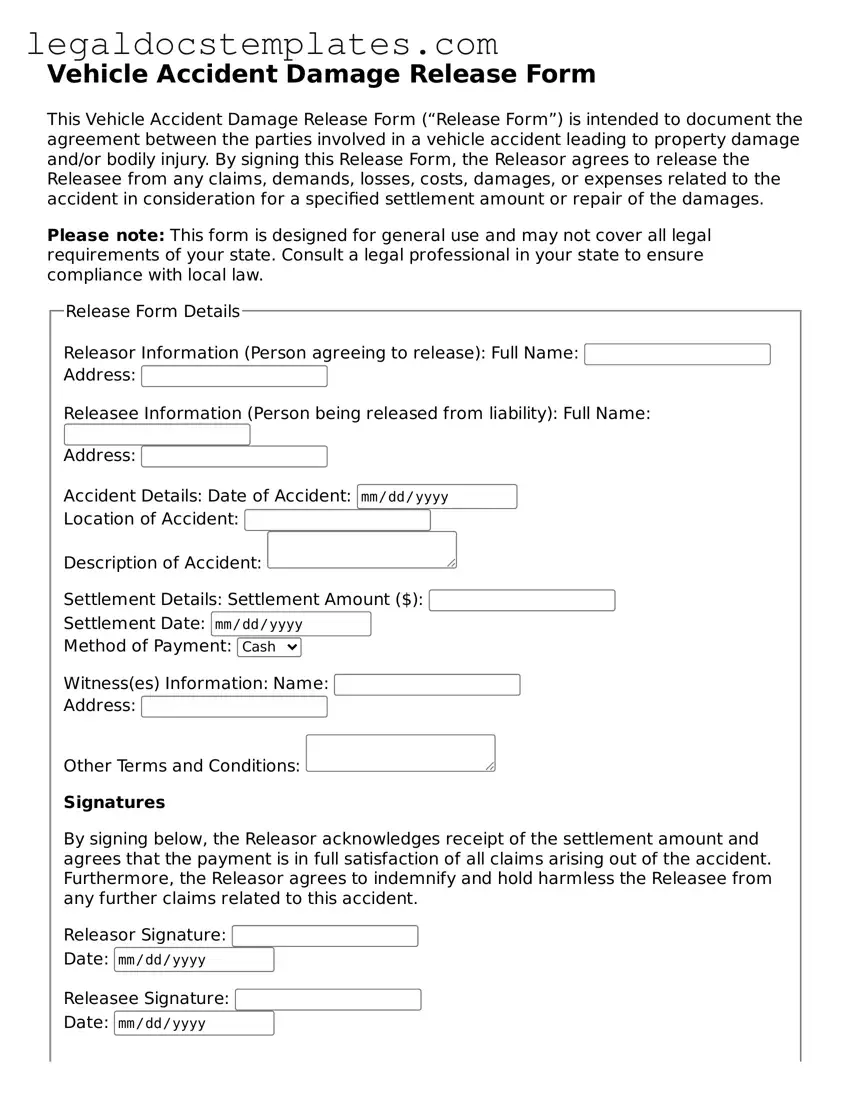The Vehicle Accident Damage Release form bears similarity to the Liability Waiver Form. Both documents serve the purpose of absolving a party (or parties) from responsibility for certain events or damages. Specifically, a liability waiver is often used in events or activities that may pose a risk of injury, stating that the participant accepts the risks involved. Similarly, a Vehicle Accident Damage Release form is used when an agreement is reached concerning the settlement of vehicle damage claims, effectively releasing the responsible party from further liability related to the accident.
Another similar document is the Property Damage Release Form. This form is utilized when settling claims related to property damage, enabling the damaged party to agree on a compensation amount from the party responsible for the damage. Just like the Vehicle Accident Damage Release form, it finalizes the settlement and absolves the responsible party from further claims related to the specific incident of property damage. Both forms are crucial in legally documenting the resolution of damages and compensations.
The General Release of Liability Form shares commonalities with the Vehicle Accident Damage Release form too. It is a broad document that releases an individual or entity from any legal liability for any potential accidents or injuries. While the General Release can cover various scenarios, the Vehicle Accident Damage Release is specific to vehicle accidents. Both forms, however, finalize an agreement where one party agrees not to hold the other legally responsible for certain incidents.
A Medical Release Form is notably similar as well in its function of granting permission or releasing someone from liability. It is typically used to authorize medical professionals to share patient medical records with other parties. Unlike the Vehicle Accident Damage Release form, which deals with vehicle accidents and damages, the Medical Release concerns the sharing of health information. Nonetheless, both documents are instrumental in providing necessary permissions or releases in their respective contexts.
The Settlement Agreement Form is closely related to the Vehicle Accident Damage Release form in its essence of documenting the terms of a settlement between parties. They both are legal documents that finalize the terms of an agreement, often including financial compensation and the release of any further liability. While Settlement Agreements can apply to a wide range of disputes, the Vehicle Accident Damage Release is specific to vehicular accidents.
An Accident Waiver and Release of Liability Form is used in events or activities, much like a liability waiver, to state that participants agree not to hold organizers legally responsible for any injuries or damages incurred. It shares similarities with the Vehicle Accident Damage Release form by focusing on accidents but applies more broadly to various potential accidents, not just those involving vehicles. Both forms include an agreement to relinquish the right to legal claims against the other party involved.
The Mutual Release Agreement is another document related to the Vehicle Accident Damage Release form. In mutual releases, both parties agree to release each other from any claims, suits, or demands. This type of agreement is often used in resolving disputes without assigning blame or fault to either party. Like the Vehicle Accident Damage Release, it ends the potential for further legal actions on the matter at hand, yet it does so bilaterally, involving both parties.
The Employee Injury Release Form, used when an employee agrees not to hold their employer accountable for any work-related injuries in exchange for compensation, also shares traits with the Vehicle Accident Damage Release form. Both forms involve an agreement on the compensation for injuries or damages and a subsequent release from further claims. However, the former focuses on workplace incidents, while the latter is specific to vehicle accidents.
The Release of Promissory Note Form is somewhat akin but in a different domain. This document is utilized when a borrower has fulfilled the obligations of a promissory note, and the lender releases them from further liability. The connection with the Vehicle Accident Damage Release form lies in the concept of releasing parties from obligations upon the fulfillment of specific terms. While one focuses on financial agreements, the other deals with the settlement of claims following vehicle accidents.
Lastly, the Intellectual Property (IP) Release Form parallels the Vehicle Accident Damage Release form by handling the rights and claims related to intellectual property. An IP Release Form typically involves an agreement to transfer rights or to release claims to intellectual property. Even though it spans a very different subject matter, the conceptual basis of releasing claims or rights against another party under agreed-upon conditions is a common ground shared with the Vehicle Accident Damage Release form.
